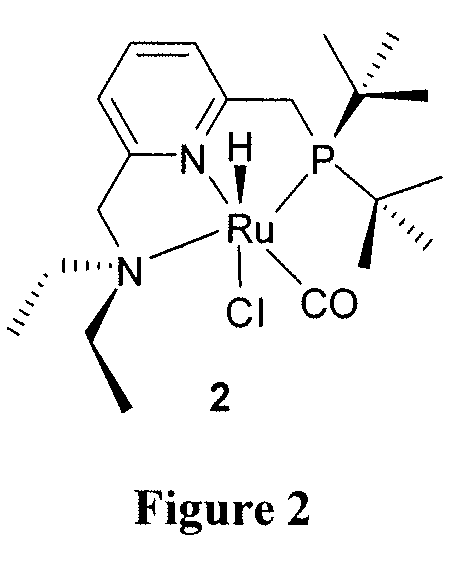Process for preparing amides from alcohols and amines
- Summary
- Abstract
- Description
- Claims
- Application Information
AI Technical Summary
Benefits of technology
Problems solved by technology
Method used
Image
Examples
example 1
Representative Procedure for Catalytic Dehydrogenative Mono-Acylation Of Primary Amines and Alcohols
[0108]This example provides a typical procedure for the catalytic dehydrogenative mono-acylation of primary amines with alcohols (Table 1): Complex RuH(CO)(PNN*) 1 (0.01 mmol), an alcohol (10 mmol), an amine (10 mmol) and toluene (3 mL) were taken in a Schlenk flask under an atmosphere of purified nitrogen in a Vacuum Atmospheres glove box. The flask was equipped with a condenser and the solution was refluxed with stirring in an open system under argon for the specified time (Table 1). After cooling to room temperature, the consumption of starting materials was checked by GC using a Carboxen 1000 column on a HP 690 series GC system.
[0109]Purification of amides in entries 1-3, and 10: After completion of reaction, the reaction mixture was cooled and allowed to stand at room temperature, during which the product amides crystallized from the solution. The solution was decanted and the so...
PUM
| Property | Measurement | Unit |
|---|---|---|
| Equivalent mass | aaaaa | aaaaa |
| Equivalent mass | aaaaa | aaaaa |
| Structure | aaaaa | aaaaa |
Abstract
Description
Claims
Application Information
 Login to View More
Login to View More - R&D
- Intellectual Property
- Life Sciences
- Materials
- Tech Scout
- Unparalleled Data Quality
- Higher Quality Content
- 60% Fewer Hallucinations
Browse by: Latest US Patents, China's latest patents, Technical Efficacy Thesaurus, Application Domain, Technology Topic, Popular Technical Reports.
© 2025 PatSnap. All rights reserved.Legal|Privacy policy|Modern Slavery Act Transparency Statement|Sitemap|About US| Contact US: help@patsnap.com



